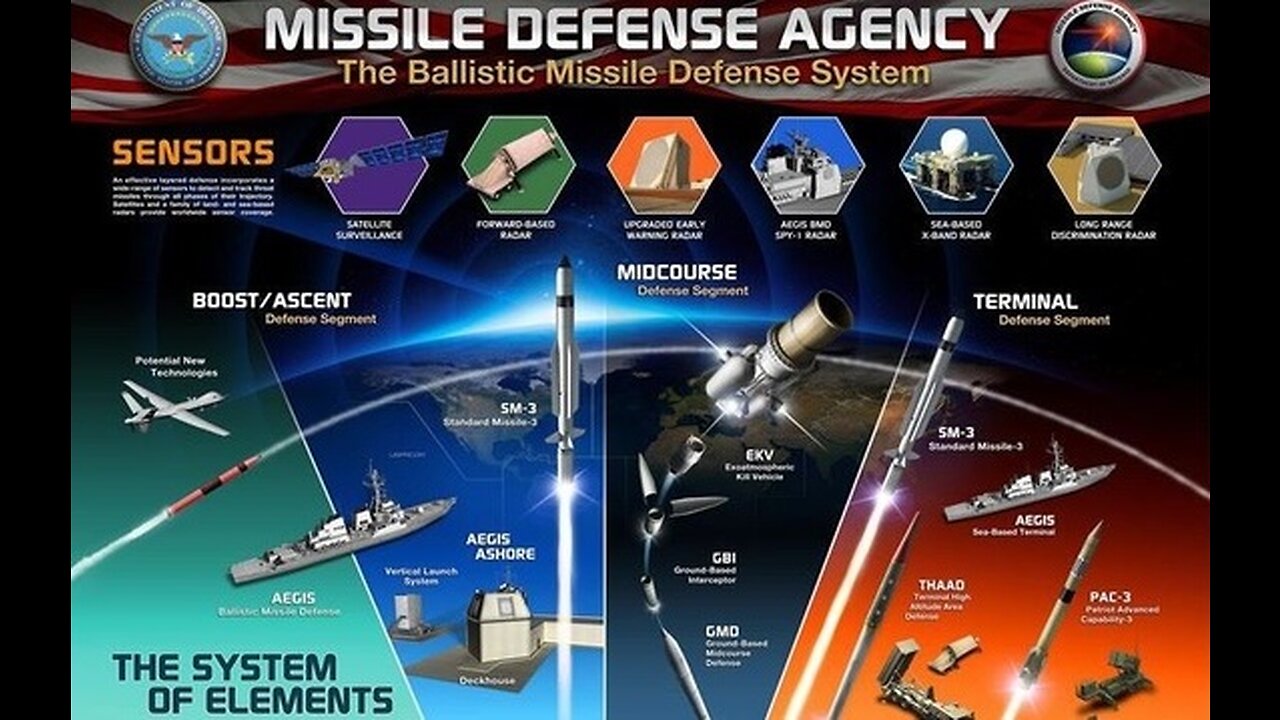Premium Only Content

China-Russia Without A Crew Assault Weapons-Combat Systems 100+ In U.S.A. Now
Just about every nation has secret missile platforms hidden in shipping containers. Every developed nation with a sizeable military is faced with an ongoing challenge: developing ways to maintain an offensive or defensive edge in a world full of rapidly advancing technologies and ever-aware covert intelligence efforts.
While the Cold War was in many ways a battle of economic investment and technological wit, the global arms race going on in today’s digital world is producing new (and sometimes terrifying) weapons aimed at swaying the balance of power on the geopolitical stage at just as fast a rate.
However, not all new weapons leverage cutting edge technology — in fact, some of the most versatile and troubling new systems are based on a combination of tried and true tech, which has been around for some time, and good old fashioned tomfoolery. Such is the case with “containerized” weapon systems.
At their simplest, “containerized” weapon systems are really nothing more than weapons built to carry everything they need to function inside a standard shipping container. At their most complex, they combine state of the art tech with existing weapons to create powerful hidden systems. “Containerized” tech is nothing new — many nations including Russia, Israel, China, and the United States have had various “containerized” weapons in their stockpile for years now. But what’s troubling about these systems isn’t their technology, but rather their use potential.
The most obvious and valuable use for containerized weapon systems would be enhancing the offensive or defensive capabilities of a large vehicle or static location. Ships with large decks like the Marine Corps‘ amphibious assault vessels or the Navy’s massive carriers could see their on-board suite of weapons bolstered by shipping containers delivered easily by using existing infrastructure. Those weapons could then be deployed, used, and redeployed elsewhere when needed.
However, a secondary and more nefarious use for containerized weapons could be the concealment of missile systems in port cities around the world. China, as an example, has such a massive export enterprise and it’s not at all uncommon for countless container ships carrying thousands of containers from China to be parked in American ports each day. It isn’t logistically feasible to visually inspect each and every container immediately, this leaves the opportunity for containers to be mislabeled intentionally, and potentially create an environment ripe for storing offensive weapons right on American shores.
“Containerized missiles give China, Russia, and its rogue state partners new options for directly or indirectly attacking the United States and its allies,” said Rick Fisher, a senior fellow at the International Assessment and Strategy Center, who specializes in studying the Chinese military.
“Shipping container missile launchers can be smuggled through ports or via highway ports of entry and stored for years in a climate-controlled building within range of U.S. military bases, and taken out when needed for military operations.”
Now, most of these weapon systems are not of the “doomsday” variety — for instance systems like Russia’s Club K container missiles are designed to engage surface ships and ground targets. These systems are self-contained and capable of using target data relayed to them from other sources, which means a Russian container ship gleaning data from Russian operatives secretly working within the United States could make for an extremely effective tactical combination, which although wouldn’t be enough to serve as part of a primary offensive, could still feasibly be a part of a broader effort.
Such an effort could be bolstered by foreign-flagged “missile merchant” ships made out of existing container vessels that could steam into port just in time to launch a bevy of strikes against nearby targets. This could allow an offensive force to establish a foothold in a port area. In fact, a piece published by the U.S. Naval institute last year proposed that the U.S. Navy does something precisely like that to bolster its own surface fleets.
“Because the expensive sensor suites will be off-hull, the cost to convert such ships to missile platforms should be modest, assuming the employment of standard Mark 41 VLS 8-cell modules or purpose-built ConEx boxes. Using standard 20- or 40-ft. long freight containers offers the advantage of several different loading systems and intermodal handling systems ashore,” the proposal read.
In the hands of groups that don’t answer to formal governments, containerized weapons would obviously pose a more immediate risk, as governments work to balance political and diplomatic repercussions with pursuits of national interest, whereas terror groups don’t. A system like Russia’s Club K, the land attack equivalent of China’s YJ-18C now being containerized, Israel’s Lora or Northrop Grumman’s containerized missiles could allow for targeted strikes against just about anything within hundreds of miles of public ports or common shipping lanes.
Because a massive global shipping infrastructure already exists, and many nations don’t delineate firmly between corporate and government interests, delivering weapons of these types to ports across the world and even shipping them to other strategic locations within foreign nations is more a question of cutting through bureaucratic red tape than anything else. This may mean that ports all over the world may already have a few missile systems parked in their vicinity.
HIDDEN STRIKE China feared to be hiding missiles in shipping containers for Trojan Horse-style plan to launch attack ANYWHERE in world now. CHINA has been secretly developing Trojan Horse-style missiles hidden in shipping containers that can be unleashed on enemy ports, experts warn.
Military analysts believe the country’s huge fleet of freighters and fishing vessels could be turned into warships with the use of the secretive container missiles.
Disguised as a regular shipping containers, they can be sneaked on board a vessel to blend in seamlessly with the hundreds of others on board.
The sheer number of container ships in the world makes them harder to pinpoint than warships in the event of war.
Like the fabled Trojan Horse, the missiles would be quietly smuggled into or near an enemy port on a civilian vessel before being unleashed in a surprise attack.
Rick Fisher, senior fellow in Asian military affairs at the International Assessment and Strategy Center, told The Sun Online while Chinese have not officially confirmed they have the missiles - it is likely they have them.
And the it was warned in a study by Stockton Center for International Law that the weapons could violate naval laws.
Meanwhile, retired Navy Capt. Jim Fanell, a former Pacific Fleet intelligence chief, previously said a containerized anti-ship missile would add a significant threat to the US Navy.
It comes amid a new wave of tensions between the US and China as the Communist giant challenges Washington's status as the world's top superpower. Tensions between the West and Russia are at boiling point over the ongoing conflict in Ukraine and the migrant crisis in Belarus.
Isabel Sawkins, a research fellow at the Henry Jackson Society specialising in Russia, told The Sun Online that Russia and China joining forces could "potentially could be catastrophic" for Western powers.
She said: "Bringing China into the conversation is a deadly addition for the West.
"This would mean America's standing in the world will be absolutely shot to pieces.
"If you have Russia and China working together the US is going to go into absolute panic.
"Because China is on its way up in the world. It's not only a massive economy - they have so much power. "You would have China working with Russia and them both having this anxiety over the West - and that brings them together. That's a really terrifying prospect."
A Russian company is marketing a devastating new cruise missile system known as Club-K which can be hidden inside a shipping container, giving any merchant vessel the capability to wipe out an aircraft carrier. Potential customers for the system include Kremlin allies Iran and Venezuela, but defense experts worry that countries could pass on the satellite-guided missiles to terrorist groups. Additionally, Israel recently launched a containerized ballistic missile from Patria’’ 120mm NEMO breech-loaded mortar as well as 122mm unguided artillery rockets.
Deadly new Russian weapon hides in shipping container A Russian company is marketing a devastating new cruise missile system which can be hidden inside a shipping container, giving any merchant vessel the capability to wipe out an aircraft carrier.
Potential customers for the formidable Club-K system include Kremlin allies Iran and Venezuela, say defense experts. They worry that countries could pass on the satellite-guided missiles, which are very hard to detect, to terrorist groups.
“At a stroke, the Club-K gives a long-range precision strike capability to ordinary vehicles that can be moved to almost any place on earth without attracting attention,” said Robert Hewson of Jane’s Defense Weekly, who first disclosed its existence.
A promotional video for the Club-K on the website of Moscow-based makers Kontsern-Morinformsistema-Agat shows an imaginary tropical country facing a land, sea and air attack from a hostile neighbor.
It fights back by loading three shipping containers concealing Club-Ks onto a truck, a train and a ship, disperses them, and then launches a devastating strike on its enemy, destroying its warships, tanks and airfields.
“The idea that you can hide a missile system in a box and drive it around without anyone knowing is pretty new,” said Hewson, who is editor of Jane’s Air-Launched Weapons.
“Nobody’s ever done that before.”
Hewson estimated the cost of the Club-K system, which packs four ground or sea-launched cruise missiles into a standard 40-foot shipping container, at $10-20 million.
“Unless sales are very tightly controlled, there is a danger that it could end up in the wrong hands,” he said.
The promotional video showed how an ordinary shipping container with the Club-K inside could be hidden among other containers on a train or a ship. When required, the roof lifts off and the four missiles stand upright ready to fire.
An official reached by telephone at makers Kontsern Morinformsistema-Agat declined to answer questions about the Club-K.
He said the firm had no spokesman and he needed time to study written questions before passing a request to the firm’s management.
Russia is one of the world’s top arms exporters, selling a record $8.5 billion of weapons last year to countries ranging from Syria and Venezuela to Algeria and China. Its order book is estimated to top $40 billion.
Mikhail Barabanov, a defense expert at Russia’s Center for Analysis of Strategies and Technologies (CAST), said that as far as he understood, the Club-K was still at the concept stage.
“Potential clients include anyone who likes the idea,” he said. “It is known that the United Arab Emirates has shown interest in buying the Club.”
Barabanov said the Club-K used proven missiles from Novator, an established Russian maker of weaponry including anti-submarine, surface-to-air and submarine-launched missiles.
One of the missiles on offer is a special anti-ship variant with a second stage which splits off after launch and accelerates to supersonic speeds of up to Mach 3. “It’s a carrier-killer,” said Hewson of Jane’s. “If you are hit by one or two of them, the kinetic impact is vast...it’s horrendous.”
A Military Drone With A Mind Of Its Own Was Used In Combat, U.N. Says Military-grade autonomous drones can fly themselves to a specific location, pick their own targets and kill without the assistance of a remote human operator. Such weapons are known to be in development, but until recently there were no reported cases of autonomous drones killing fighters on the battlefield.
Now, a United Nations report about a March 2020 skirmish in the military conflict in Libya says such a drone, known as a lethal autonomous weapons system — or LAWS — has made its wartime debut. But the report does not say explicitly that the LAWS killed anyone.
"If anyone was killed in an autonomous attack, it would likely represent an historic first known case of artificial intelligence-based autonomous weapons being used to kill," Zachary Kallenborn wrote in Bulletin of the Atomic Scientists.
The assault came during fighting between the U.N.-recognized Government of National Accord and forces aligned with Gen. Khalifa Haftar, according to the report by the U.N. Panel of Experts on Libya.
"Logistics convoys and retreating [Haftar-affiliated forces] were subsequently hunted down and remotely engaged by the unmanned combat aerial vehicles or the lethal autonomous weapons systems such as the STM Kargu-2 ... and other loitering munitions," the panel wrote.
The Kargu-2 is an attack drone made by the Turkish company STM that can be operated both autonomously and manually and that purports to use "machine learning" and "real-time image processing" against its targets.
The U.N. report goes on: "The lethal autonomous weapons systems were programmed to attack targets without requiring data connectivity between the operator and the munition: in effect, a true 'fire, forget and find' capability."
"Fire, forget and find" refers to a weapon that once fired can guide itself to its target.
The idea of a "killer robot" has moved from fantasy to reality
Drone warfare itself is not new. For years, military forces and rebel groups have used remote-controlled aircraft to carry out reconnaissance, target infrastructure and attack people. The U.S. in particular has used drones extensively to kill militants and destroy physical targets.
Azerbaijan used armed drones to gain a major advantage over Armenia in recent fighting for control of the Nagorno-Karabakh region. Just last month, the Israel Defense Forces reportedly used drones to drop tear gas on protesters in the occupied West Bank, while Hamas launched loitering munitions — so-called kamikaze drones — into Israel.
What's new about the incident in Libya, if confirmed, is that the drone that was used had the capacity to operate autonomously, which means there is no human controlling it, essentially a "killer robot," formerly the stuff of science fiction.
Not all in the world of security are concerned.
"I must admit, I am still unclear on why this is the news that has gotten so much traction," Ulrike Franke, a senior policy fellow at the European Council on Foreign Relations, wrote on Twitter.
Franke noted that loitering munitions have been used in combat for "a while" and questioned whether the autonomous weapon used in Libya actually caused any casualties.
Jack McDonald, a lecturer in war studies at King's College London, noted that the U.N. report did not make clear whether the Kargu-2 was operating autonomously or manually at the time of the attack.
While this incident may or may not represent the first battlefield killing by an autonomous drone, the idea of such a weapon is disquieting to many.
A global survey commissioned by the Campaign to Stop Killer Robots last year found that a majority of respondents — 62% — said they opposed the use of lethal autonomous weapons systems.
Israel Just Launched A Containerized Ballistic Missile From The Deck Of A Ship
Long-range weapons the size and shape of shipping containers can turn almost any ship quickly into an impromptu missile boat. Though the concept has yet to find its big break, defense contractors continue to expand on the idea of highly mobile weapon systems that meet the size and weight restrictions of standard shipping containers. Now, Israel has tested such a system and says it has buyers already in line.
On June 20, 2017, Israel Aerospace Industries (IAI) said it had successfully test-fired its Long-Range Artillery (LORA) system from a containerized launcher on the back of a truck sitting on the deck of a cargo ship. The state-operated firm first unveiled the mobile ballistic missile back in 2006. The experiment, which destroyed a pre-planned target, was part of final trials ahead of “several deals that involve the system,” according to a press release.
"This was one of the most complexed [sic] trails [sic; trial] we held over the past few years and a technological breakthrough for IAI's missile development operations,” Boaz Levi, the company’s Executive Vice President and General Manager of Systems, Missiles & Space Group, said. “The trail [sic; trial] was held according to a full operational outline, including an assessment of the system's maneuvering, assault and precision capabilities.” According to IAI's website and a company fact sheet, the 3,500-pound solid-fuel LORA can hit targets nearly 250 miles away within 10 minutes thanks to an unspecified “supersonic velocity." The missile has a penetrating warhead of some type and relies on GPS and inertial navigation to get it to the target area. However, once it’s there, an operator can course correct using a command-to-target television guidance system giving the missile incredible accuracy. This dual-mode configuration has become a staple of Israel missile technology and is very similar to that found on the Delilah cruise missile and the much smaller Spike NLOS missile from Israeli government-owned company Rafael. The man-in-the-loop terminal guidance technique was developed over decades, with weapons like the Popeye/Have Nap paving the way for this current generation of highly advanced dual-guidance missile systems. It also means that if need be, the weapon can hit targets in spite of bad weather, smoke, or other obscurants that would interfere with a laser or optical terminal guidance arrangement. According to IAI, a notional complete containerized LORA battery would include a command and fire control container and four launchers, each with four missiles, plus four reload vehicles. On land, trucks would carry these components, giving them additional mobility and the ability to escape a first strike. At sea, the self-contained nature of the system means a customer could easily load it onto any vessel with the appropriate space, quickly turning it into a stand-off weapon platform. Since the command section has all the equipment necessary to launch the missiles, no other modifications to the ship are necessary.
In a maritime environment, the obvious benefits of these systems are relatively low cost launchers and the lack of need for a dedicated missile-armed vessel. A system with this type of range could provide precision strikes and timely fire support deep into enemy territory without the use of fixed-wing air power and the risks that go along with it.
A military could purchase only a small number of LORA systems and simply move them from ship to ship as necessary. Depending on the defensive capabilities of the opponent, logistics ships or other auxiliaries could suddenly become impromptu combatants, freeing up purpose-built and better defended warships for tasks in more dangerous environments. The LORA's cruise-missile-like range could potentially keep even less well protected ships out of the way of shore-based defenses altogether. There’s a long-standing fear that rogue states or other enemy forces might use innocuous, civilian-styled container carriers to launch sneak attacks, too.
Of course, using civilian or civilian-style ships as missile boats in a pinch isn’t a perfect solution and presents its own possible complexities. Standard container carriers and the like are not intended for military operations and lack any real defensive considerations. They aren’t meant to hide or otherwise conceal themselves and don’t have the sort of systems on board to detect, avoid, or neutralize incoming threats or search out potential targets. To be fair, surface-to-air missiles, close-in-weapon systems, surface search radars, and other sensors could all fit inside containers, too. Many of these concepts could be quickly lifted from existing sea base-type ships, which the War Zone has already written extensively about in the past.
But these are especially important considerations given the proliferation of land-based anti-ship cruise missiles, with ever increasing range and speed. Many countries, particularly Russia and China, appear to be pursuing so-called Anti-Access/Area Denial (A2AD) strategies, which combine these types of weapons with long-range radars and integrated air defense networks, which could turn whole regions into no-go areas for foreign air and naval forces during an actual conflict.
Still, hiding in plain sight so to speak has its grand advantages and its own tactical justification in itself depending on the scenario, and for lower intensity conflicts such a capability would be both effective in cost effective and remarkably easy to deploy.
It’s important to note that containerized weapons are not new, nor are such missile launchers with naval applications specifically. In 2010, Russian began advertising a four-round launcher for the 3M-54 Kalibr cruise missile, variants of which have a similar range to the LORA, hidden inside a shipping container. They revealed a version of the complete system, commonly known as Club-K, to the public at the annual MAKS air show in 2011. There are also much shorter-range systems, too. These include a containerized version of Patria’s 120mm NEMO breech-loaded mortar and a Chinese system that can accommodate 122mm unguided artillery rockets, as well as cruise missiles. Theoretically, almost any truck-mounted artillery or missile system would have very similar flexibility as long as there was sufficient room on a ship’s deck. But no one has put these into active service to our knowledge.
Based on available concept art, Russia is planning to employ a system like the Club-K on its up-coming Ice-class icebreaking corvettes. And the U.S. Army and Marine Corps are both actively looking at the potential to use the High Mobility Artillery Rocket System (HIMARS) as an anti-ship weapon, possibly afloat on U.S. Navy ships. Our own Tyler Rogoway posited installing it on the Navy's ammo-less Zumwalt-class stealth destroyers. The HIMARS launcher can already fire the Army Tactical Missile System (ATACMS, and pronounced “attack-ums”), which has similar range to the LORA, as well as the small but more plentiful and highly accurate M30/31 guided artillery rockets. Raytheon is working on a replacement for the out of production ATACMS, called DeepStrike.
Unlike Israel, however, U.S. cruise and ballistic missiles are limited by the Intermediate-Range Nuclear Forces Treaty, more commonly known as the INF, which it signed with the Soviet Union in 1987. Russia and the United States have agreed to abide by the terms, though U.S. officials accuse their Russian counterparts of breaking the deal, which says neither party can build missiles with maximum ranges between 300 and 3,400 miles. Over and under are just fine, and Raytheon's goal is a missile that can fly right to the edge of minimum allowable distance, but no further, significantly further than the range of ATACMS.
Still, the truth is that LORA and similar containerized weapons systems may revolutionize how naval warfare is executed and how ships that are meant to execute it are built. Building simpler, cheaper surface combatants with areas for containerized weapons may be commonplace in the future. The U.S. Coast Guard wants to follow in Russia's footsteps and put containerized cruise missile systems on their future icebreakers. There has been talk about integrating similar modular systems on future lower-end U.S. Navy ships. This type of capability, and even existing concepts such as the Phalanx CIWS-based Centurion defense system, seem extremely well suited for America's various sea basing and special operations support platforms. So could the Navy of the future include an armada of container toting ships? It is a real possibility.
IAI claims it has actual customers for the naval LORA system, but there's no indication that the U.S. military is among them. Since there is only the press release to work with, it is important to remember those deals could still be pending to some degree and might not proceed. Depending on who actually gets the launchers, and if they actually employ them in a naval setting, it might give other countries such as the United States added impetus to move ahead with their own similar projects.
Northrop Grumman Shows Off Shipping Container-Launched Anti-Radiation Missile Concept - The idea pairs a standard ISO shipping container with the latest and greatest anti-radiation missile technology.
The Association of the United States Army conference and expo is underway in Washington DC and our own Joe Trevithick was making the rounds around the show floor and spotted a very interesting concept from Northrop Grumman. It takes the increasingly popular containerized weapons trend and mixes it with the company's newest anti-radiation missile designs, the AARGM, which is the advanced AGM-88E version of the long-proven High-Speed Anti-Radiation Missile (HARM), and the longer-range AARGM-ER with its sleeker form factor. You can read all about that missile here. In essence, such a system could place enemy threat emitters at risk in a persistent manner anywhere within the range of launcher's missiles. And that containerized launcher could be located on a road or at sea, as well as in semi-fixed positions.
These missiles can be fired in a lock-on after launch manner, flying out to a certain area where an enemy emitter is active before locking on and making their terminal attacks. Being networked, they can even be retasked in flight. Electronic surveillance aircraft, including fighters equipped with advanced electronic support measures suites and operating deep behind enemy lines, could detect electronic threats and call up these surface-based missiles remotely on demand to suppress and/or destroy those threats. This not only drastically expands magazine depth for tactical aircraft when it comes to countering SAM sites and other hostile air-defense nodes, but it also adds a high level of unpredictability to counter-air defense operations. These missiles aren't just anti-radiation missiles anymore, really. They are uniquely capable of prosecuting time sensitive and fleeing targets from standoff ranges—even those that may have stopped emitting electromagnetic energy, or never even emitted any all. The AGM-88E can be told to strike a target at a particular GPS coordinate and its active radar seeker can even track and refine its attack path on a target that begins to move away from that area. This is especially deadly for road-mobile anti-aircraft systems, but it can also be so for other target types, as well.
So yes, you get an incredibly capable anti-radiation missile that can even blast emitters that stop broadcasting with a high degree of certainty, but you also get a missile that can destroy smaller time-sensitive targets, including ships and vehicles on the move within a certain geographical area. Oh, and it can do all that while careening towards its target at over Mach two.
If anything else, this concept is another reminder of how the very understanding of the suppression and destruction of enemy air defenses (SEAD/DEAD) missions are evolving in unique and creative ways. This goes along with the sentiments of one of the most famous Wild Weasel and fighter pilots of our time, Dan Hampton. In an interview from April of 2017 with The War Zone, Hampton stated:
"There are ways in and around those systems and I will go back to one of my life-long premises—anything that kills a SAM or part of a SAM can be a Wild Weasel. So it doesn't necessarily mean it's me in a tactical airframe. It might be special forces teams on the ground blowing up radars. It might be naval warships standing offshore if they're within range of their guns and just blasting the hell out of them."
But really, this idea isn't entirely new. Israel, a country that has pioneered many SEAD/DEAD concepts, adapted the AGM-78 Standard air-launched anti-radiation missile to be fired from the ground via a specialized M809 truck-mounted box launcher system. This system, deployed in the 1980s, was called 'Keres' (Hook) with missile itself being called 'Egrof Segoal' (Purple Punch). The AGM-78 was itself a retooled SM-1 Standard ship-launched surface-to-air missile—talk about coming full circle.
Although the AGM-78 packed a big warhead—215lbs—that system wasn't even as remotely as capable, as versatile, or as long-reaching as the AGM-88E and its forthcoming sister missile, the AARGM-ER.
An even cruder Israeli ground-based anti-radiation missile system predates Keres. The 'Kilshon' was basically an AGM-45 Shrike anti-radiation missile that launched from a rail mounted atop an M4A1 Sherman tank. This system served throughout the 1970s following the Yom Kippur War and was eventually replaced by Keres.
Eventually, Harpy suicide drones and their successors replaced Keres and the land-based anti-radiation missile concept in IDF service, but in some ways, it is still alive today. In this day and age, Israeli ground-launched cruise missiles get fed coordinates of active enemy radar systems and are fired at those sites on short order. These cruise missiles, such as the ground-launched Delilah, lack the speed of their anti-radiation predecessors. Now, Israel also has an evolved series of guided artillery rockets that are very fast, but not as long-ranged, and they don't possess the ability to chase down active emitters or moving targets.
Yet what makes this concept most exciting is its modularity and deployability. It can be strapped to the deck of a ship, carted around by a semi or flatbed truck, or get airlifted into a remote firebase. It could even potentially be hidden aboard a vessel masquerading as a civilian transport, ready to provide fast-reacting suppression of enemy air defenses capabilities in support of an incoming aerial assault. Because it uses a standard ISO container, under very certain circumstances the system could even potentially be snuck into enemy territory, or into a less hostile country that shares a border with it, and be used by surprise to kick-down the enemy's air defenses ahead of or during an air operation—all without even putting an aircraft at risk.
Using this system during a ground operation in contested territory could help significantly with providing protection for Army helicopters and other lower-flying assets from pop-up radar-guided anti-aircraft artillery and road-mobile SAM systems.
The containerized weapon system concept began to emerge about a decade ago and has steadily become an increasingly attractive and versatile deployment concept for both higher-end and lower-end combat capabilities. Russia, in particular, has embraced the idea and is now designing entire ships around it. The U.S. seems to be following suit, albeit slowly.
We will keep an eye out to see if or how this concept evolves, but regardless, it really does underline just how capable and flexible the next generation of anti-radiation missiles really are.
A Russian weapons company, Morinformsistema-Agat, is marketing a cruise missile system that is hidden inside an ordinary 40’ cargo shipping container and can be launched from inside the container itself. The Club K Missile system is able to “fire four long range satellite-guided missiles from a ship, train or tractor-trailer.” It has the ability to demolish an aircraft carrier as far as 200 miles away. Currently, the Club K Missile system is said to be marketed internationally only as a military weapon, but it is likely that they will be willing to sell to whomever is financially apt to purchase this $10 million weapon.
Concerns arise as WSBTV’s news anchor Justin Farmer further investigates and finds that officials at the Port of Savannah is unaware of this missile system. The Port of Savannah is “United States’ fourth-largest container port” transporting over three million containers each year. Ideally, each container is monitored and scanned by U.S. Customs and Border Protection at the Port of Savannah before moving inland. However, even with the latest x-ray technology, not 100% of all cargo is being scanned. While each truck is inspected for radiation before it leaves the port, it is possible that the Club K Missile contains conventional substances that may or may not trigger the detectors. The officials at the Port of Savannah concludes by ensuring that this new missile would not be overlooked during the inspection process and the systems that are employed at the port would most definitely detect such cargo passing through.
It is certainly a threat to our country if such massive weaponry can be hidden in a container that is meant to ship ordinary cargo. This disguise allows for a vast amount of ways in which the cruise missiles can be used. It can transform any ordinary 40’ cargo container into a missile boat and can easily destroy an aircraft carrier. Or it can be taken inland and be fired from within the nation’s defense system. This advanced missile system could potentially put the nation at risk. After various encounters with terrorism and how it has affected national security over the years, careful measures should be taken and strict regulations should be permanently enforced to ensure safety. If additional safety procedures are not taken to carefully scan and inspect all cargo entering the states, then our country will be in a great amount of danger in the future.
The Air Force’s New Weapon Is…Shipping Containers?
The USAF could sprinkle potential battlefields and hotspots with shipping containers years in advance, each hiding a lethal drone.
The U.S. Air Force is considering a pitch by a defense contractor to deploy armed drones in shipping containers.
The drones, XQ-58 Valkyries, are short takeoff drones with performance nearing that of a fighter jet.
In the event of war the Air Force could launch swarms of drones from the containers to overwhelm an enemy.
The U.S. Air Force wants the ability to deploy hundreds of drones across a future theater of war, storing them in shipping containers until the moment they are needed. Drone maker Kratos Defense is proposing inserting its new XQ-58A Valkyrie drone in a modified shipping container, which would then be shipped or flown to small islands in the Pacific. In the event of war, the drones could be quickly readied for action, flying long range missions deep into enemy territory while armed with precision guided bombs and air-to-air missiles. The concept, proposed by Kratos Defense, calls for fitting a XQ-58A Valkyrie into a standard sized shipping container. The XQ-58A is considered “runway independent”, meaning it does not need long runways for takeoffs and landings. Kratos has long built target drones that are launched from a short, skyward-pointed rail, using rocket boosters to get airborne. Once in the air, the drone’s turbofan engine takes over and the drone goes on its way.
Kratos thinks the XQ-58A, rocket boosters, and launcher rail could all fit inside a shipping container. In the event of a crisis with China, the Air Force could deploy the shipping containers to small islands in the Pacific, either by ship or C-130J Super Hercules transport. A small number of Air Force personnel would also deploy with the containers. The XQ-58A Valkyrie is one of a new generation of drones with near-fighter jet capabilities. The drone is 30 feet long with a 27 foot wingspan, has a top speed of Mach .95, and can carry up to two 250 pound GBU-39 Small Diameter Bombs.
If war starts, it would take the airmen a “very small number of hours,” according to a Kratos official quoted at Flightglobal, to prepare the drone for action. The airmen could load the drone with a pair of GBU-39s or even small air-to-air missiles, attach the wings (the drone won’t fit in the shipping container with wings attached), and wait for the signal to fire. The process would be repeated at secret locations throughout the region, with scores or even hundreds of drones made ready to fight.
One of the XQ-58A’s best features is its 3,000 nautical-mile range. Valkyries stored on the U.S. territory of Guam, for example, could easily reach Hong Kong, Shanghai, and even Beijing. Drones stored even closer to China could range even deeper into the country. Meanwhile, U.S. aircraft carriers, land attack cruise missiles, and strategic bombers would conduct attacks on Chinese military targets. The XQ-58A’s long range means that in any future war Chinese military leaders would face the prospect of not only fighting in the Pacific but also protecting Chinese airspace from armed, long range drones.
The Air Force, as Flightglobal points out, appears interested in the concept. The site notes General C.Q. Brown, recently nominated to be the next head of the Air Force, said in 2019, “If a 20-foot container can actually contain some type of weapon system and I have 1,000 20-foot containers spread throughout the region, as an adversary, which one is the one that actually has the capability? Which one is just empty?”
The Kratos drone container concept is pretty cheap: each drone is projected to cost just $2-3 million, with the shipping container/launcher costing an eighth to a tenth of that. By comparison, a F-35A Joint Strike Fighter costs about $90 million. As retired Marine Corps Colonel T.X. Hammes points out in another piece on Flightglobal, the total lifetime cost of a F-35A is about $352 million. A drone like the XQ-58A can’t replace the F-35, but it can offer unique capabilities that would complement the manned jet—for a lot less money.
-
 17:51
17:51
What If Everything You Were Taught Was A Lie?
5 days agoHow Satan & Vatican Pedophile's Hide Their Trillion Of Dollar's Gold, Art, Real Estate Global Wealth
1.84K2 -
 1:45:02
1:45:02
Glenn Greenwald
3 hours agoIsrael Slaughters More Journalists, Hiding War Crimes; Trump's Unconstitutional Flag Burning Ban; Glenn Takes Your Questions | SYSTEM UPDATE #504
68K46 -
 LIVE
LIVE
Stephen Gardner
40 minutes ago🔥'Burn ALL TRUMP FLAGS’ says Tim Walz + Democrat CAUGHT rigging own election!
518 watching -
 10:10
10:10
robbijan
1 day agoHollywood’s Hidden Messages: Predictive Programming & What’s Next
1.13K2 -
 40:13
40:13
MattMorseTV
2 hours ago $3.62 earned🔴It's EVEN WORSE than we thought...🔴
12K34 -
 LIVE
LIVE
The Jimmy Dore Show
3 hours agoSnoop Dogg Is DONE w/ LBGTQ+ Propaganda In Kids Movies! Trump Outlaws Burning the U.S. Flag!
7,283 watching -
 LIVE
LIVE
MissesMaam
4 hours agoDying Light w/ Da Bois💚✨
122 watching -
 LIVE
LIVE
Sgt Wilky Plays
1 hour agoThe Finals with the Pack
37 watching -
 32:55
32:55
Clickbait Wasteland
9 hours ago $0.21 earnedAsking New Yorkers Who They Support For Mayor: Wall Street
3.29K1 -
 LIVE
LIVE
Spartan
55 minutes agoLittle bit of Halo and Expedition 33
11 watching